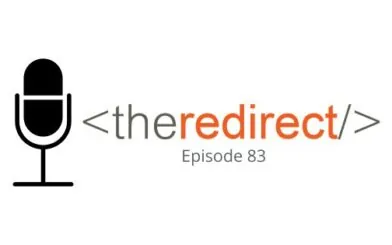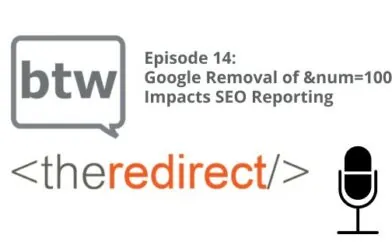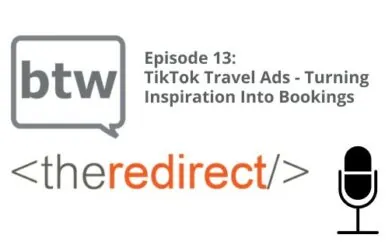Episode 32 / February 2, 2018
In this week’s episode:
- A simple breakdown and explanation of the differences between search index, rank, and how those two get confused by even search professionals (begins at 27:43).
- Further discussions around Amazon’s Alexa devices, their growth in the marketplace beyond voice search, and how their “Alexa Skills” could impact brand experience (begins at 3:33 and 10:53).
- Taking a step back, actionable tips on what it means to simplify your content, as well as develop it with a purpose in mind that can impact search and user experience in a positive way (begins at 17:45).
Before we jump in, there were some other great updates and articles in the realm of search this week. Some quick mentions at the beginning of the podcast:
- A great piece from Angela Petteys on Google Tag Manager over on the Moz Blog.
- Google published a pretty comprehensive guide for featured snippets that’s quite in-depth for those who might like to geek out on this topic.
- What Page Should You Link Your Google My Business Listing To? from Darren Shaw at Whitespark
Google’s Page Speed Update Does NOT Impact Indexing
In light of Google’s recent announcement of a page speed update, there appears to be a bit of confusion amongst many in the industry over whether this affects indexing. To clear things up, let’s define what it means for a website to be indexed, vs. being ranked.
To explain it simply, when a site gets indexed, it means Google (or Bing) is able to crawl through the pages within the site and categorize it. Originally, we could say it was like categories in a library or book store, but today it closely resembles your Netflix feed.
A site that ranks is completely different than one that’s just simply in the index. If we keep in mind that the index is the way to categorize and organize, RANK is where a page or site falls within those categories when a user submits a search query. If a page can’t be indexed, it certainly can’t be ranking, right?
The confusion, as Search Engine Roundtable’s Barry Schwartz points out, is that many are of the assumption that Google gives up on pages that are slow to load when trying to index them. So if the page speed update impacts those really slow pages, is this an indexing factor or a ranking factor?
What it comes down to is that the page speed update does not determine whether or not a page is indexed. It impacts those pages that are already indexed.
Crystal clear, right?
Amazon Echo Show
Patrick previously made a bold prediction in episode 27 that voice search will fizzle out this year. He is keeping track of developments in this area, including news related to voice assistant devices.
“It wasn’t supposed to be like this,” starts off a review of the new Amazon Echo Show, which is an Alexa device with a touchscreen. Yes, a voice search device that has a screen. Which is a cheap solution to a problem no one knew how to fix: How to skip to the second option in a search result. So in other words, the Echo Show is a stationary tablet. Or a tablet on a permanent base.
The review I read stated that the screen did, in fact, improve Alexa. It created hundreds of different graphics and “add-on” type benefits of the screen, and it entirely changed the experience. However, the reviewer stated that you can still use the Show with voice-only commands if you are not right in front of it.
The reviewer, who said the Show is an overall improvement, said that some perks of having the screen include that while playing music, it will show lyrics and song information, as well as having the ability to make video calls a la Skype or FaceTime.
So again, it’s a stationary tablet – something that the majority of tech-friendly houses already have in their house. I (Patrick) do not see the benefit.
Fizzle, Part II: Patrick Gets a Smart Home Device
To play to both sides of the aisle: I will admit, my home is now connected to a voice assistant. Two of them, in fact. They come in the form of Ecobee4 smart thermostats equipped with a built-in Amazon Alexa device.
They were installed 2 weeks ago. Honestly, I was excited, and even with all my griping and predicting that voice assistants’ popularity would fizzle out, I wanted to see if I could find a way to incorporate these devices into my life with the way I currently use technology. I must disclose that I qualify myself as very tech-savvy – not a whiz, but very savvy. (I could be considered an “IT guy” at a place that employed a majority of Boomers.) And I was having trouble with it.
(As a preface to sharing my experience, I should mention that my household is heavy on Amazon Prime product use, but we don’t use the paid Amazon music add-on. We’re a paid Spotify house. We shop a lot on Prime, and we use Prime Video, and Prime Photos. We don’t use any of the advanced Prime shopping features.)
I quickly learned that I had to go to a desktop and learn “Alexa Skills” in order to communicate with my new smart devices. I started by adding in the “Ecobee” skills. Once I did that, I attempted to command my thermostats to increase the temperature one degree. Alexa asked, “Which one?” (I have a hallway thermostat and a bedroom thermostat, named accordingly). I said, “Hallway!” And then Alexa told me, “I’m sorry, I can’t do that.”
Seriously.
So I just pulled my phone out of my pocket, opened the Ecobee app, and turned the hallway thermostat up one degree.
Later, with a little dance party action, we tried to get Alexa to play Michael Jackson’s greatest hits. It kept playing Alan Jackson, country superstar. Later, when we kept trying to say the command differently, Alexa said “Did you mean Michael Jackson’s “top songs?” (Semantics.) Yes, Alexa. You do that. And then it played one song.
I found an “Alexa Skill” for Spotify, so I added it. Then I asked my device to use Spotify. “I’m sorry,” Alexa said. “Your device is not compatible with Spotify.”
I give up.
I’m over it.
Back to Basics: Simple Content Strategy for Easy Content Management
I recently began re-reading Kristina Halvorson’s Content Strategy for the Web. In the very first chapter, she explains why “less is more” when it comes to web content. Case in point: The more content you have on your website, for instance, the more there is to maintain over time. (Content, of course, is not a “set it and forget it” kind of thing. As Halvorson writes often in this book, it needs regular “care and feeding.”)
Considering the concept of less being more, I’d wager than when a site is going through a re-launch, it’s much more common for the site to re-launch with less content than it had before, rather than more. (Clear exceptions would be if the site was very light in content in its legacy version, or the business has grown significantly and the site is being updated to reflect those changes.)
Halvorson explains that all content should serve at least one of these two purposes:
- Support a key business objective
- Support a user or customer in completing a task.
In other words, don’t create content just to create content. Content creation is not a strategy in an of itself, right? So just make sure whatever you create can be linked back to one of those two key purposes for your specific business. (Discussion of quality content also
We often work with clients who are re-launching their site, and/or migrating to HTTPS. This is a key time to perform an audit and consider what content stays, goes, or is redirected for more effective content management going forward.
If you happen to be launching a brand new site for a new endeavor, it’s in your best interest to begin the whole process with a simple content strategy that can be carried forward as the site grows. Starting with less, and with a clear strategy in mind, means you’ll ultimately have less rogue content to wrangle in the future.
Thanks for tuning in! To catch future episodes of The Redirect Podcast, subscribe on SoundCloud, iTunes, or Stitcher.



